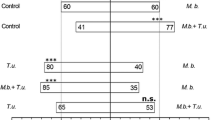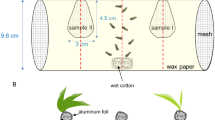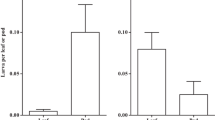Abstract
We found that intact lima bean plants increased the secretion of extrafloral nectar (EFN) after exposure to Tetranychus urticae-induced plant volatiles. Predatory mites, Phytoseiulus persimilis, dispersed more slowly from an exposed intact plant than from a control plant (plant exposed to volatiles from intact conspecific). The predators also dispersed more slowly from those plants that were provided with extra EFN than from untreated plants. We further show that EFN was a potential alternative food source for P. persimilis. From these results, we concluded that increased EFN was involved in the slow dispersal of P. persimilis from the plants exposed to herbivore-induced plant volatiles. Our data suggest that the increase of EFN in an HIPV-exposed intact plant could be an induced indirect defense against spider mites.




Similar content being viewed by others
References
Agrawal AA, Rutter MT (1998) Dynamic anti-herbivore defense in ant--plants: the role of induced responses. Oikos 83:227–236
Arimura G., Ozawa R, Shimoda T, Nishioka T, Boland W, Takabayashi J (2000) Herbivory-induced volatiles elicit defence genes in lima bean leaves. Nature 406:512–515
Arimura G, Ozawa R, Nishioka T, Boland T, Koch T, Kuhnemann F, Takabayashi J, (2002) Herbivore-induced volatiles induce the emission of ethylene in neighbouring lima bean plants. Plant J 29:87–98
Bruin J, Sabelis MW, Dicke M (1995) Do plants tap SOS signalsfrom their infested neighbours?. Trends Ecol Evol 10:167–170
Bruin J, Dicke M, Sabelis MW (1992) Plants are better protected against spider--mites after exposure to volatiles from infested conspecifics. Experientia 48:525–529
Choh Y, Shimoda T, Ozawa R, Dicke M, Takabayashi J (2004) Exposure of lima bean leaves to volatiles from herbivore-induced conspecific plants results in emission of carnivore attractants: active or passive process?. J Chem Ecol 30:1305–1317
Creelman RA, Mullet JE (1997) Oligosaccharins, brassinolides, and jasmonate: nontraditional regulators of plant growth, development, and gene expression. Plant Cell 9:1211–1223
Dicke M, Sabelis MW, Takabayashi J, Bruin J, Posthumus MA (1990) Plant strategies of manipulating predator-prey interactions through allelochemicals: prospects for application in pest control. J Chem Ecol 16:3091–3118
Dolch R, Tscharntke T (2000) Defoliation of alders (Alnus glutinosa) affects herbivory by leaf beetles on undamaged neighbours. Oecologia 125:504–511
Engelberth J, Alborn HT, Scmelz EA, Tumlinson JH (2004) Airborne signals prime plants against insect herbivore attack. Proc Nat Acad Sci USA 101:1781–1785
Gaume L, McKey D (1999) An ant--plant mutualism and its host-specific parasite: activity rhythms, young leaf patrolling, and effects on herbivores of two specialist plant--ants inhabiting the same myrmecophyte. Oikos 84:130–144
Heil M, Koch T, Hilpert A, Fiala B, Boland W, Linsenmair KE (2001) Extra-floral nectar production of the ant-associated plant, Macaranga tanarius, is an induced, indirect, defensive response elicited by jasmonic acid. Proc Nat Acad Sci USA 98:1083–1088
Heil M (2004) Induction of two indirect defences benefits lima bean (Phaseolus lunatus, Fabaceae) in nature. J Ecol 92:527–536
Horiuchi J, Arimura G, Ozawa R, Shimoda T, Dicke M, Takabayashi J, Nishioka T (2003) Lima bean leaves exposed to herbivore-induced conspecific plant volatiles attract herbivores in addition to carnivores. Appl Entomol Zool 38:365–368
Karban R, Baldwin IT, Baxter KJ, Laue G, Felton GW (2000) Communication between plants: induced resistance in wild tobacco plants following clipping of neighboring sagebrush. Oecologia 125:66–71
Nomikou M, Janssen A, Sabelis MW (2003) Phytoseiid predators of whiteflies and reproduce on non-prey food sources. Exp Appl Acarol 31:15–26
Mondor EB, Addicott JF (2003) Conspicuous extra-floral nectaries are inducible in Vicia faba. Ecol Lett 6:495–497
Raine NE, Willmer P, Stone GN (2002) Spatial structuring and floral avoidance behavior prevent ant-pollinator conflict in Mexican ant-acacia. Ecology 83:3086–3096
Raine NE, Gammans N, Macfadyen IJ, Scrivner GK, Stone GN (2004) Guards and thieves: antagonistic interactions between two ant species coexisting on the same ant-plant. Ecol Entomol 29:345–352
Rudgers JA (2004) Enemies of herbivores can shape plant traits: selection in a facultative ant-plant mutualism. Ecology 85:192–205
Van Rijn PCJ, Tanigoshi LK (1999) The contribution of extrafloral nectar to survival and reproduction of the predatory mite Iphiseius degenerans on Ricinus communis. Exp Appl Acarol 23:281–296
Wäckers FL, Zuber D, Wunderlin R, Keller F (2001) The effects of herbivory on temporal and spatial dynamics of foliar nectar production in cotton and castor. Ann Bot 87:365–370
Wasternack C, Parthier B (1997) Jasmonate-signaled plant gene expression. Trends Plant Sci 2:302–307
Wickers S (1997) Study of nectariferous secretion in a pioneer plant, Inga thibaudiana, in relation with ants. Acta Bot Gallica 144:315–326
Acknowledgements
We thank Merijn van Tilborg for his comments on the manuscript. This study was supported by CREST of JST (Japan Science and Technology Corporation).
Author information
Authors and Affiliations
Corresponding author
Additional information
Communicated by Julia Koricheva
Rights and permissions
About this article
Cite this article
Choh, Y., Kugimiya, S. & Takabayashi, J. Induced production of extrafloral nectar in intact lima bean plants in response to volatiles from spider mite-infested conspecific plants as a possible indirect defense against spider mites. Oecologia 147, 455–460 (2006). https://doi.org/10.1007/s00442-005-0289-8
Received:
Accepted:
Published:
Issue Date:
DOI: https://doi.org/10.1007/s00442-005-0289-8




